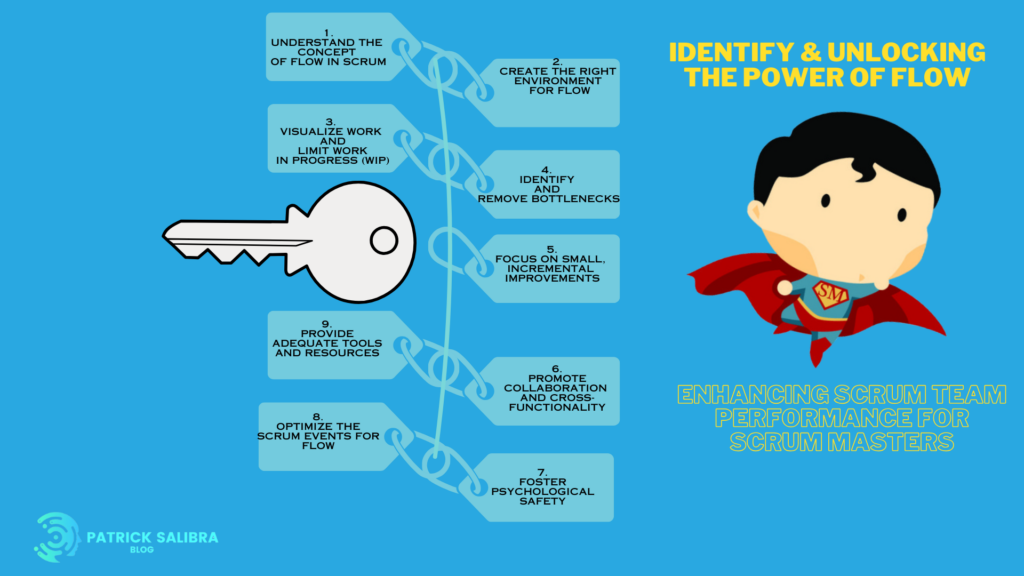
1. Introduction
Collaboration is a key component of any successful Scrum team, and the role of the Scrum Master is crucial in facilitating this collaboration. In order to enhance the performance of a Scrum team, Scrum Masters must understand, identify and unlock the power of flow. Flow is a state of deep focus and optimal performance where team members are fully engaged and working seamlessly together towards a shared goal. By utilizing specific techniques and strategies, Scrum Masters can create an
environment that fosters flow and enables their teams to achieve peak performance.
In this blog post, i will explore the concept of flow and discuss practical ways for Scrum Masters to unlock its power and enhance the performance of their Scrum teams.
2. Concept of flow
In the realm of Scrum, flow means the ability to move work through the Scrum process with minimal interruptions or delays. Flow occurs when team members are fully immersed in their work, and the team experiences less waste, fewer bottlenecks, and reduced context switching. It’s closely related to concepts like Lean thinking, Kanban, and Continuous Delivery.
Flow is typically characterized by:
- Fast cycle times: Work items are completed quickly without unnecessary delays.
- High focus: Team members are focused and not distracted by irrelevant tasks or multi-tasking.
- Clear goals and purpose: Everyone knows what the next task is, and there’s alignment across the team on what to deliver.
- Minimal handoffs: Work moves smoothly from one team member to the next without excessive delays or misunderstandings.
- Work in Smaller Batches: Dividing large broken work into smaller parts contributes to an optimal flow

To create an environment that fosters flow, Scrum Masters must first recognize the factors that contribute to this state. These factors include a clear vision and shared purpose, autonomy in decision-making, a supportive team culture, and the presence of challenging yet achievable tasks. By understanding and addressing these factors, Scrum Masters can unlock the power of flow and enable their teams to reach optimal performance levels.
In the next section of this blog post, we will discuss practical strategies and techniques that Scrum Masters can employ to cultivate flow within their Scrum teams. Stay tuned to learn how you can maximize team performance by harnessing the power of flow.
3. The role of the Scrum Master in optimizing team flow
The role of the Scrum Master is pivotal in optimizing team flow. As a facilitator and facilitator, the Scrum Master plays a crucial role in creating an environment that fosters flow within the Scrum team.
One key responsibility of the Scrum Master is to ensure that the team has a clear vision and shared purpose. By facilitating regular communication and collaboration, the Scrum Master can help the team align their individual goals with the overall project objectives. This alignment is crucial for creating a sense of focus and motivation, which are essential elements of flow.

Additionally, the Scrum Master must empower team members with autonomy in decision-making. By allowing individuals to
have a say in how work is prioritized and executed, the Scrum Master encourages ownership and engagement. This
autonomy not only boosts motivation but also enhances the team’s ability to work fluidly together.
Moreover, the Scrum Master plays a vital role in cultivating a supportive team culture. By fostering an environment of trust,
respect, and open communication, the Scrum Master encourages collaboration and cooperation. When team members feel
valued and supported, they are more likely to work harmoniously and achieve a state of flow.
Lastly, the Scrum Master can optimize team flow by providing challenging yet achievable tasks. By carefully balancing the level of difficulty and the team’s skill set, the Scrum Master can stimulate engagement and flow. Too easy tasks can lead to boredom, while tasks that are too challenging can cause frustration. The Scrum Master must closely observe the team’s capabilities and adjust the complexity of tasks accordingly.
4. Keys Aspects of a Flow
Below are a number of key aspects that can help identify, improve and optimize a team flow. By approaching them correctly, a scrum team can help along the way after delivering value.
- Understand the Concept of Flow in Scrum
- Create the Right Environment for Flow
- Visualize Work and Limit Work in Progress (WIP)
- Identify and Remove Bottlenecks
- Focus on Small, Incremental Improvements
- Promote Collaboration and Cross-functionality
- Foster Psychological Safety
- Optimize the Scrum Events for Flow
- Provide Adequate Tools and Resources

5. Conclusion: Empowering Scrum Masters to unlock the power of flow
In conclusion, Scrum Masters play a critical role in unlocking the power of flow within Scrum teams. By implementing the
strategies and techniques discussed in this blog, they can empower their teams to enhance their performance and achieve
better project outcomes.
The clear and well-defined Definition of Done (DoD) ensures that the team has a shared understanding of the expectations
and criteria for completing each user story or task. Breaking down larger tasks into smaller, manageable pieces allows for a
smoother flow of work and increased feedback opportunities. Conducting regular retrospective meetings enables the team to
reflect on their performance and make necessary adjustments. Visual management techniques, such as Kanban boards or
task boards, provide transparency and help the team prioritize and manage their work more effectively.
By implementing these techniques and empowering Scrum Masters to facilitate their teams, organizations can unlock the full
potential of flow and drive success in their Agile projects.
Ultimately, flow is about reducing friction in the process, enhancing collaboration, and enabling the team to focus on delivering value. By embracing the principles of flow, Scrum Masters can foster a high-performance culture that drives continuous improvement and long-term success.

Disclaimer: The composition of an Agile Team is different for every environment and the way they operate. This blog is not so much a ready-made solution to your challenge but more of an incentive to help you with a possible solution(s)

